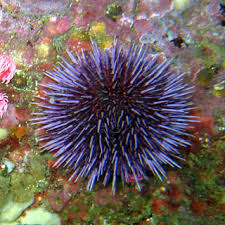Sea urchin

- The sea urchin is a spiny and hard-shelled sea animal which lives on the rocky seafloor, from shallow waters to great depths. These globular marine invertebrates move very slowly along the seabed. There are about 700 different species of sea urchins worldwide.
- Two common species of sea urchins are the red (Strongylocentrotus franciscanus) and purple
(S. purpuratus), in shallow waters of California. Both species have been implicated in the decline of kelp beds. - In Japan, sea urchins are protected rather than destroyed. Many sea urchins have venomous spines. The biggest sea urchin is the red sea urchin (Strongylocentratus franciscanus); having a test about 7 inches (18 cm) in diameter.

